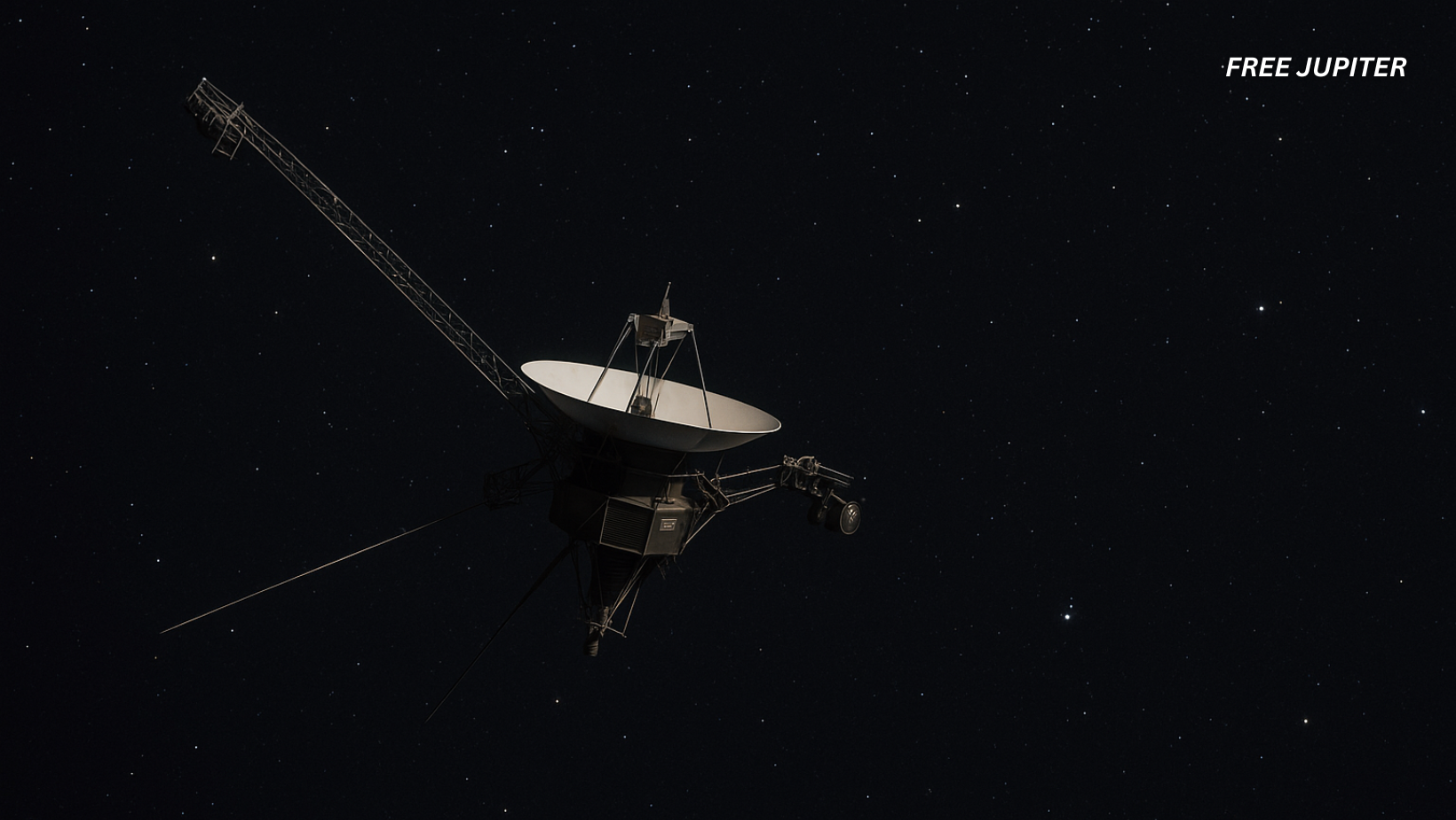Friendly Note: FreeJupiter.com shares general info for curious minds 🌟 Please fact-check all claims—and always check health matters with a professional 💙
When most people think about space exploration, they imagine distant planets, glowing stars, and the dream of humans stepping foot on Mars. What doesn’t often come to mind is speed—specifically, how fast our machines need to go just to break free from Earth’s gravity and head into the cosmos.
One spacecraft in particular has made speed not just a necessity but a legacy: Voyager 1, the farthest human-made object from our planet. Launched in 1977, this aging spacecraft is still zooming through interstellar space almost half a century later.
Recently, a YouTube channel called Airplane Mode decided to help people grasp Voyager 1’s unbelievable speed by simulating what it would look like if it were traveling here on Earth, at ground level. The result shocked viewers—because seeing speed in action feels far different from reading it as a number on a page.
How Fast Is Voyager 1 Really Going?
To understand why people were so stunned, it helps to know the numbers. Voyager 1 is currently moving at around 38,000 miles per hour (61,000 kilometers per hour) relative to Earth. That’s nearly 17 kilometers every single second.
For comparison:
- A commercial jet averages about 575 mph (925 km/h).
- A bullet fired from a handgun moves around 1,700 mph (2,735 km/h).
- The fastest Formula 1 car tops out near 230 mph (370 km/h).
Voyager 1 makes all of these seem like they’re crawling. At its pace, you could fly from New York to Los Angeles in under five minutes. You could circle the entire Earth in just over an hour.
On Earth, such speed would be catastrophic—objects moving that fast at ground level would be nearly impossible to track with the naked eye. That’s why the simulation made such an impact. Seeing Voyager 1 “zipping past” as though it were a vehicle in traffic is almost frightening. It looks less like science and more like science fiction.
Read more: Scientists Create Plastic From Grapevine Waste That Breaks Down in Only 17 Days
Why Does Spacecraft Travel So Quickly?
Here’s the funny part: Voyager 1 wasn’t even launched with the intention of becoming the fastest spacecraft ever. Its journey was designed around gravity assists—essentially using planets’ gravitational pull as slingshots to gain speed.
After launching from Cape Canaveral in 1977, Voyager 1 took advantage of Jupiter and Saturn’s massive gravity wells to slingshot itself out of the solar system. Each encounter added a boost, much like pushing a child higher and higher on a swing.
And unlike cars or planes, there’s nothing in deep space to slow it down. No air resistance. No friction. Once Voyager 1 picked up speed, it simply kept going, coasting along the cosmic highway at tens of thousands of miles per hour.
A Quick Recap of Voyager 1’s Mission
Voyager 1 wasn’t just built to be fast—it was built to be curious. Together with its twin, Voyager 2, it set out to explore the outer planets.
Some of its greatest achievements include:
- 1979: Detailed images of Jupiter’s clouds and moons, including volcanic activity on Io.
- 1980: A close encounter with Saturn, capturing stunning images of its rings and discovering new moons.
- 1990: The famous “Pale Blue Dot” image, showing Earth as a tiny speck from 3.7 billion miles away.
After its planetary tour, Voyager 1 kept traveling outward until it eventually crossed into interstellar space in 2012—the first spacecraft in history to do so.
Today, it continues sending faint signals back to Earth, though its instruments are slowly shutting down as its power source runs out. By 2030, it may finally fall silent, drifting endlessly through the galaxy.
Why the Simulation Feels So Surreal
So why does seeing Voyager 1’s speed on Earth shock people more than hearing the raw numbers? It’s because humans are visual creatures. Our brains evolved to understand speed in terms of running animals, flowing rivers, or racing storms. Numbers like “38,000 miles per hour” don’t have much meaning in daily life.
But put that number into an Earth-based context—like a car whizzing by at that pace—and it suddenly becomes terrifying. Imagine standing on a sidewalk and watching something flash past at tens of thousands of miles per hour. You wouldn’t even have time to process it—it would be gone in an instant, leaving only shockwaves and devastation behind.
That’s why the simulation is so effective: it transforms abstract science into something tangible.
Read more: Humpback Whales Keep Saving Animals From Orcas—And No One Knows Why
Putting Voyager’s Speed Into Perspective
To truly appreciate Voyager 1’s journey, it helps to compare it with more familiar benchmarks:
- Cars and Highways: If Voyager 1 were driving across the United States, it would complete the entire coast-to-coast trip (New York to California) in under five minutes.
- Around the Globe: At its current pace, Voyager 1 could circle the Earth’s equator (about 24,900 miles) in just over 40 minutes.
- To the Moon: The spacecraft could travel from Earth to the Moon (238,900 miles) in about 6.5 hours. By comparison, Apollo astronauts took around three days.
- To Mars: At its current speed, Voyager 1 could reach Mars (average 140 million miles away) in about 153 days. That’s still much slower than light, but much faster than any rocket carrying humans today.
And yet, here’s the kicker: even at this mind-bending speed, Voyager 1 would still need around 75,000 years to reach the nearest star system, Proxima Centauri. Space is that unimaginably vast.
Why Voyager 1 Matters Beyond the Science
Voyager 1 isn’t just a spacecraft—it’s a message in a bottle, drifting through the stars. Onboard is the Golden Record, a copper phonograph disc containing sounds, images, and greetings from Earth. It’s a time capsule designed for any intelligent life that might encounter it.
The record includes everything from greetings in 55 languages to music from Bach, Beethoven, and Chuck Berry, along with recordings of whales, birds, and even a mother’s kiss.
At its speed, Voyager 1 might pass near other star systems millions of years from now, carrying a small piece of human culture with it. The simulation of its speed on Earth isn’t just about numbers—it’s a reminder of humanity’s bold leap into the unknown.
What the Simulation Teaches Us
The reason videos like the one created by Airplane Mode resonate so deeply is because they bridge the gap between science and imagination. They take something abstract and make it feel immediate.
Voyager 1’s speed isn’t just about raw data—it’s about perspective. It forces us to realize how small and slow our everyday lives are compared to the scale of the universe.
At the same time, it highlights human ingenuity. A spacecraft built with 1970s technology is still out there, traveling at breathtaking speeds, sending whispers across billions of miles. It’s a testament to what humanity can achieve when curiosity pushes us forward.
Read more: Scientists Discover Natural Molecule That Wipes Out 90% of Cavity-Causing Plaque
Final Thoughts
The simulation of Voyager 1’s speed at ground level has left people astonished—and for good reason. Seeing a spacecraft move that quickly on Earth feels impossible, even dangerous. Yet in the emptiness of space, that velocity is just what’s needed to make progress across the endless dark.
Voyager 1 may be tiny compared to the scale of the galaxy, but it represents something huge: the human drive to explore, to wonder, and to leave a trace of ourselves beyond the boundaries of home.
So next time you hear the phrase “38,000 miles per hour,” remember: that’s not just a number. It’s a blur of speed, a messenger from Earth, and one of the most extraordinary achievements in the story of human exploration.










